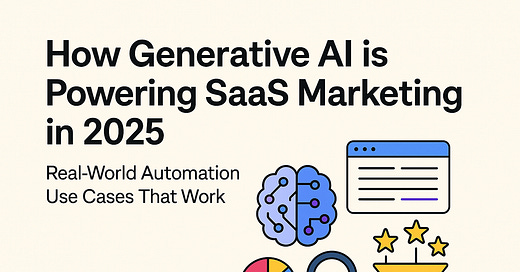In just a few years, generative AI has gone from a shiny new trend to a key player in SaaS marketing.
But if you're an indie developer or running a lean software company, you might still be wondering:
“Is this actually worth my time and budget, or just another tech fad?”
Good news: real-world results say yes. Generative AI is already showing measurable ROI for SaaS businesses of all sizes.
Note: For confidentiality reasons, some company names in this article have been changed. However, the strategies and outcomes are based on real-world SaaS use cases.
Let’s Look Beyond the Hype
We’ve moved past the novelty phase. According to McKinsey’s 2023 report “The Economic Potential of Generative AI,” companies using AI in their marketing are already seeing:
30–40% reduction in content creation time
Up to 25% improvement in campaign performance
15–30% decrease in operational costs, directly lowering CAC
So, how are they doing it? Let’s dive into five real-world examples.
1. Hyper-Personalized Content at Scale
Case: TaskFlow, a small project management app, had to compete with giants like Asana. Their edge? Extreme personalization.
They used AI to analyze user behavior during free trials and automatically generate:
Emails tailored to onboarding challenges
Scripted video tutorials based on use case
Personalized value propositions by industry
Results:
+34% trial-to-paid conversions
–18% churn in just 3 months
🧠 Framework You Can Use:
Identify key behavior signals from users
Create modular message templates with variables
Match behavior to messages using AI
Collect feedback to improve content relevance
2. Smart Support That Solves Problems
Case: DataViz, a visualization SaaS, started with a rule-based chatbot, leading to poor CX and ticket overload.
They upgraded to an AI assistant trained on:
Internal docs & FAQs
Anonymized chat history
Updated tech guides
The new bot could handle non-linear flows and provide custom solutions.
Results:
78% of queries resolved autonomously (up from 34%)
52% faster first response
Customer satisfaction score increased from 3.8 → 4.6
🧠 Framework You Can Use:
Organize your knowledge base for AI
Start with human oversight
Define support KPIs (resolution rate, CSAT)
Retrain with real feedback
3. AI-Powered Copy Testing
Case: InvoiceNinja, a small billing SaaS, lacked resources for full A/B testing.
Their solution:
Use AI to generate 20 variations of headlines and CTAs
Simulate audience reactions
Prioritize the top 5 for actual A/B testing
Results:
+41% conversion lift
–75% testing budget saved
🧠 Framework You Can Use:
Segment your audience clearly
Use AI to draft multiple variants
Run simulations to pre-validate
Test only high-probability versions
4. Personalized Demo Videos on Autopilot
Case: AnalyticsHub, a data platform, found personalized demos converted best, but were hard to scale.
They built a system using generative AI and preset modules to create:
Custom demo videos based on the prospect's needs
Industry-relevant dashboards
Proposals with sector-specific language
Results:
+63% demo-to-close rate
–47% in sales cycle time
🧠 Framework You Can Use:
Build a modular library of demo elements
Classify leads by industry and goals
Let AI assemble assets based on input
Measure which demos convert best and optimize
5. SEO That Matches Search Intent
Case: LegalTech, a tool for law firms, couldn’t outspend SEO competitors.
Instead, they used AI to:
Spot micro-moments in the legal buyer journey
Write long-tail, intent-driven content
Build content hubs for conversational search
Adjust content dynamically to search algorithm changes
Results:
+187% organic traffic
+94% conversions from search
All with just 15% of the budget that their competitors used.
🧠 Framework You Can Use:
Map your customer journey and search intents
Create long-form content with AI for those intents
Interlink for better indexing
Refresh based on changing SERPs
Getting Started Without Breaking the Bank
You don’t need millions or a team of data scientists. The real success factors were:
✅ Starting with one focused use case
✅ Keeping humans in the loop
✅ Setting clear KPIs to track ROI
✅ Iterating based on real feedback
So... Where Should You Start?
If you’re exploring how to integrate AI into your SaaS marketing strategy:
Find your biggest bottleneck
Pick one high-impact use case
Start lean (use free or low-cost AI tools)
Track everything to guide your next move
Need Help Implementing This?
I work as a Fractional CMO helping SaaS teams leverage AI and automation to grow smarter, not just harder.
If you're ready to turn these ideas into action, let’s talk.
👉 Book a free 30-minute strategy session: https://calendly.com/laubolgo/free-call
Let’s map out a practical plan for your team.
If you found this article helpful, share it with a SaaS founder who might benefit.
And hit subscribe to get more real-world SaaS growth tactics every week.



